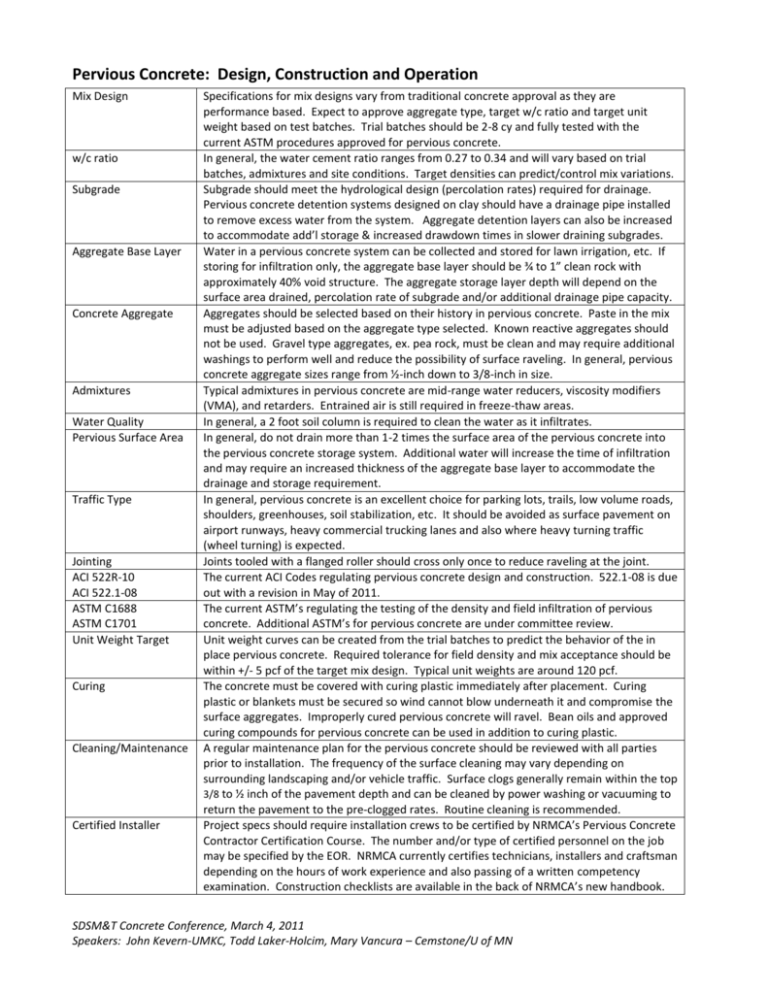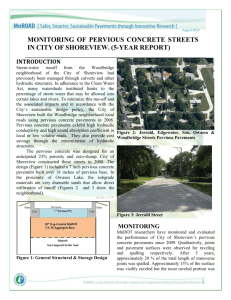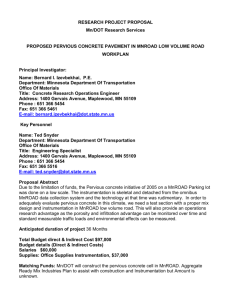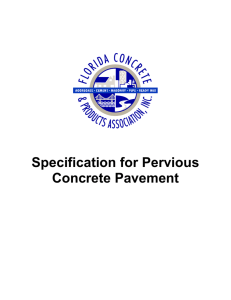Best Practices
advertisement

Pervious Concrete: Design, Construction and Operation Mix Design w/c ratio Subgrade Aggregate Base Layer Concrete Aggregate Admixtures Water Quality Pervious Surface Area Traffic Type Jointing ACI 522R-10 ACI 522.1-08 ASTM C1688 ASTM C1701 Unit Weight Target Curing Cleaning/Maintenance Certified Installer Specifications for mix designs vary from traditional concrete approval as they are performance based. Expect to approve aggregate type, target w/c ratio and target unit weight based on test batches. Trial batches should be 2-8 cy and fully tested with the current ASTM procedures approved for pervious concrete. In general, the water cement ratio ranges from 0.27 to 0.34 and will vary based on trial batches, admixtures and site conditions. Target densities can predict/control mix variations. Subgrade should meet the hydrological design (percolation rates) required for drainage. Pervious concrete detention systems designed on clay should have a drainage pipe installed to remove excess water from the system. Aggregate detention layers can also be increased to accommodate add’l storage & increased drawdown times in slower draining subgrades. Water in a pervious concrete system can be collected and stored for lawn irrigation, etc. If storing for infiltration only, the aggregate base layer should be ¾ to 1” clean rock with approximately 40% void structure. The aggregate storage layer depth will depend on the surface area drained, percolation rate of subgrade and/or additional drainage pipe capacity. Aggregates should be selected based on their history in pervious concrete. Paste in the mix must be adjusted based on the aggregate type selected. Known reactive aggregates should not be used. Gravel type aggregates, ex. pea rock, must be clean and may require additional washings to perform well and reduce the possibility of surface raveling. In general, pervious concrete aggregate sizes range from ½-inch down to 3/8-inch in size. Typical admixtures in pervious concrete are mid-range water reducers, viscosity modifiers (VMA), and retarders. Entrained air is still required in freeze-thaw areas. In general, a 2 foot soil column is required to clean the water as it infiltrates. In general, do not drain more than 1-2 times the surface area of the pervious concrete into the pervious concrete storage system. Additional water will increase the time of infiltration and may require an increased thickness of the aggregate base layer to accommodate the drainage and storage requirement. In general, pervious concrete is an excellent choice for parking lots, trails, low volume roads, shoulders, greenhouses, soil stabilization, etc. It should be avoided as surface pavement on airport runways, heavy commercial trucking lanes and also where heavy turning traffic (wheel turning) is expected. Joints tooled with a flanged roller should cross only once to reduce raveling at the joint. The current ACI Codes regulating pervious concrete design and construction. 522.1-08 is due out with a revision in May of 2011. The current ASTM’s regulating the testing of the density and field infiltration of pervious concrete. Additional ASTM’s for pervious concrete are under committee review. Unit weight curves can be created from the trial batches to predict the behavior of the in place pervious concrete. Required tolerance for field density and mix acceptance should be within +/- 5 pcf of the target mix design. Typical unit weights are around 120 pcf. The concrete must be covered with curing plastic immediately after placement. Curing plastic or blankets must be secured so wind cannot blow underneath it and compromise the surface aggregates. Improperly cured pervious concrete will ravel. Bean oils and approved curing compounds for pervious concrete can be used in addition to curing plastic. A regular maintenance plan for the pervious concrete should be reviewed with all parties prior to installation. The frequency of the surface cleaning may vary depending on surrounding landscaping and/or vehicle traffic. Surface clogs generally remain within the top 3/8 to ½ inch of the pavement depth and can be cleaned by power washing or vacuuming to return the pavement to the pre-clogged rates. Routine cleaning is recommended. Project specs should require installation crews to be certified by NRMCA’s Pervious Concrete Contractor Certification Course. The number and/or type of certified personnel on the job may be specified by the EOR. NRMCA currently certifies technicians, installers and craftsman depending on the hours of work experience and also passing of a written competency examination. Construction checklists are available in the back of NRMCA’s new handbook. SDSM&T Concrete Conference, March 4, 2011 Speakers: John Kevern-UMKC, Todd Laker-Holcim, Mary Vancura – Cemstone/U of MN








